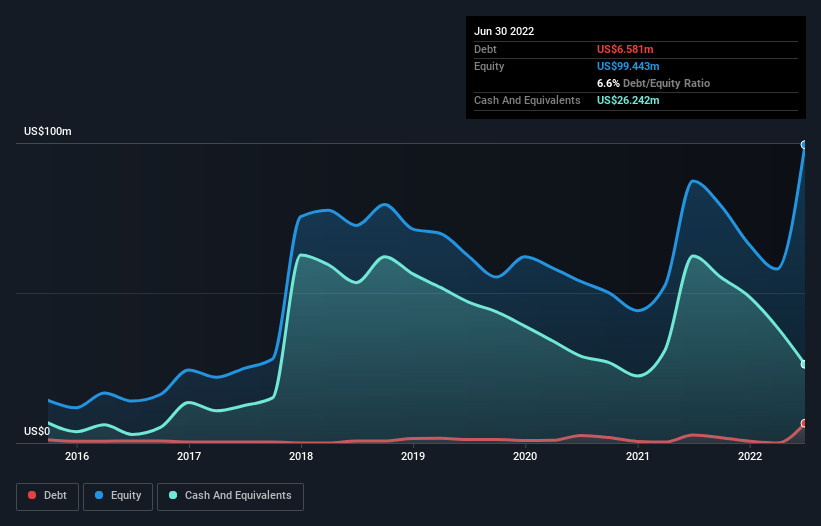Does 22nd Century Group (NASDAQ:XXII) Have A Healthy Balance Sheet?
Legendary fund manager Li Lu (who Charlie Munger backed) once said, 'The biggest investment risk is not the volatility of prices, but whether you will suffer a permanent loss of capital.' It's only natural to consider a company's balance sheet when you examine how risky it is, since debt is often involved when a business collapses. We note that 22nd Century Group, Inc. (NASDAQ:XXII) does have debt on its balance sheet. But the more important question is: how much risk is that debt creating?
When Is Debt A Problem?
Generally speaking, debt only becomes a real problem when a company can't easily pay it off, either by raising capital or with its own cash flow. Ultimately, if the company can't fulfill its legal obligations to repay debt, shareholders could walk away with nothing. While that is not too common, we often do see indebted companies permanently diluting shareholders because lenders force them to raise capital at a distressed price. Having said that, the most common situation is where a company manages its debt reasonably well - and to its own advantage. When we think about a company's use of debt, we first look at cash and debt together.
View our latest analysis for 22nd Century Group
How Much Debt Does 22nd Century Group Carry?
The image below, which you can click on for greater detail, shows that at June 2022 22nd Century Group had debt of US$6.58m, up from US$2.66m in one year. But on the other hand it also has US$26.2m in cash, leading to a US$19.7m net cash position.
A Look At 22nd Century Group's Liabilities
According to the last reported balance sheet, 22nd Century Group had liabilities of US$18.1m due within 12 months, and liabilities of US$1.91m due beyond 12 months. Offsetting these obligations, it had cash of US$26.2m as well as receivables valued at US$4.66m due within 12 months. So it actually has US$10.9m more liquid assets than total liabilities.
This short term liquidity is a sign that 22nd Century Group could probably pay off its debt with ease, as its balance sheet is far from stretched. Simply put, the fact that 22nd Century Group has more cash than debt is arguably a good indication that it can manage its debt safely. When analysing debt levels, the balance sheet is the obvious place to start. But it is future earnings, more than anything, that will determine 22nd Century Group's ability to maintain a healthy balance sheet going forward. So if you're focused on the future you can check out this free report showing analyst profit forecasts.
Over 12 months, 22nd Century Group reported revenue of US$39m, which is a gain of 32%, although it did not report any earnings before interest and tax. With any luck the company will be able to grow its way to profitability.
So How Risky Is 22nd Century Group?
We have no doubt that loss making companies are, in general, riskier than profitable ones. And we do note that 22nd Century Group had an earnings before interest and tax (EBIT) loss, over the last year. And over the same period it saw negative free cash outflow of US$32m and booked a US$44m accounting loss. But at least it has US$19.7m on the balance sheet to spend on growth, near-term. With very solid revenue growth in the last year, 22nd Century Group may be on a path to profitability. By investing before those profits, shareholders take on more risk in the hope of bigger rewards. When analysing debt levels, the balance sheet is the obvious place to start. But ultimately, every company can contain risks that exist outside of the balance sheet. Case in point: We've spotted 3 warning signs for 22nd Century Group you should be aware of.
When all is said and done, sometimes its easier to focus on companies that don't even need debt. Readers can access a list of growth stocks with zero net debt 100% free, right now.
Have feedback on this article? Concerned about the content? Get in touch with us directly. Alternatively, email editorial-team (at) simplywallst.com.
This article by Simply Wall St is general in nature. We provide commentary based on historical data and analyst forecasts only using an unbiased methodology and our articles are not intended to be financial advice. It does not constitute a recommendation to buy or sell any stock, and does not take account of your objectives, or your financial situation. We aim to bring you long-term focused analysis driven by fundamental data. Note that our analysis may not factor in the latest price-sensitive company announcements or qualitative material. Simply Wall St has no position in any stocks mentioned.
Join A Paid User Research Session
You’ll receive a US$30 Amazon Gift card for 1 hour of your time while helping us build better investing tools for the individual investors like yourself. Sign up here

